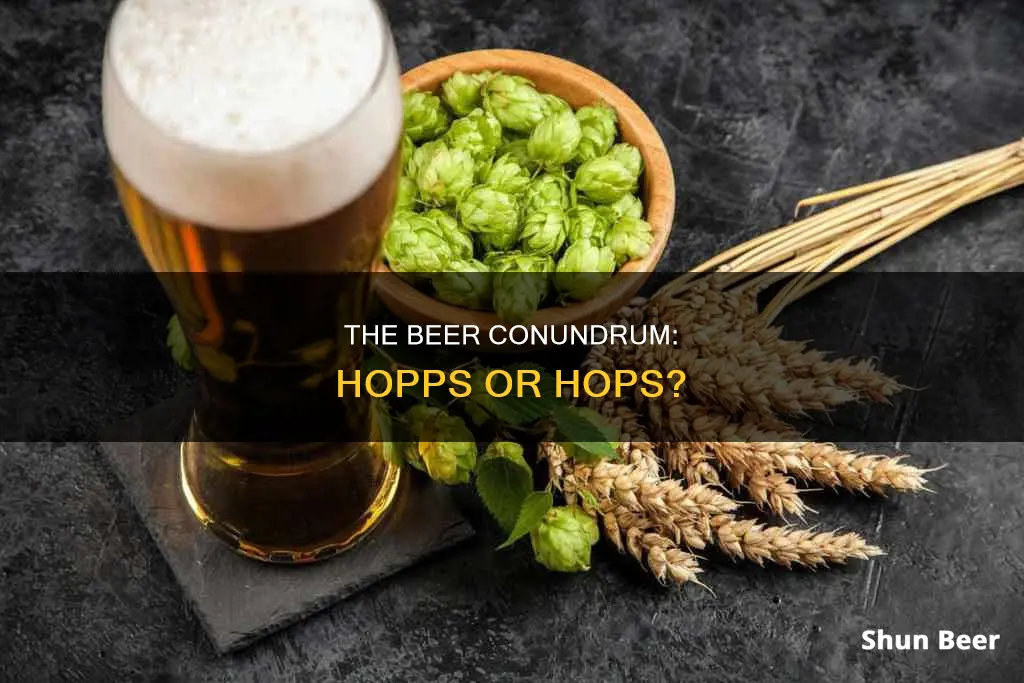
Hops are the flowers of the female hop plant, Humulus lupulus, and are one of the four essential ingredients in beer, alongside barley, yeast, and water. They are used to balance the sweetness of the malt with bitterness and a variety of flavours and aromas. Hops are also used for their antibacterial properties and as a preservative, extending the life of beer. While hops are most often associated with bitterness, they can also be dry-hopped or fresh-hopped to add aroma without the extra bitterness.
| Characteristics | Values |
|---|---|
| What are hops? | The cone-shaped flowers of the female hop plant, Humulus lupulus. |
| Hop plant description | Climbing vine or bines (vines without tendrils) |
| Hop plant family | Cannabaceae, which includes cannabis |
| Hop plant uses | Bittering, flavouring, and stability in beer; antibacterial properties; herbal medicine; tea; soft drinks |
| Hop plant grown | Worldwide, including the US, Germany, the UK, the Czech Republic, New Zealand |
| Hop types | Bittering hops; aroma hops; dual-use hops |
| Hop use in beer | Added to the boil stage of brewing; dry hopping; fresh hopping |
What You'll Learn

Hops are the flowers of the female hop plant, Humulus lupulus
Humulus lupulus has separate male and female plants, and only the female plants are used for commercial hop production. The female flowers, or hops, are used to preserve and flavour beer, so the species is widely cultivated by the brewing industry. Hops contain acids and essential oils that impart bitterness, flavour, and stability to beer. They also have antibacterial properties and act as a preservative, preventing beer from spoilage.
Hops have a long history of use in beer-making, with the first documented use dating back to the 9th century. Today, many different varieties of hops are grown by farmers around the world, with different types used for particular styles of beer.
In addition to their use in brewing, hops have also been used as a herbal remedy and in the manufacturing of various products. They are known to have anti-inflammatory, antimicrobial, diuretic, digestive, sedative, and progestogenic properties, and have been used to treat a wide range of health issues.
Hops in Beer: Necessary or Overrated?
You may want to see also

Hops add bitterness, flavour, and stability to beer
Hops, the cone-shaped flowers of the female hop plant, scientifically known as Humulus lupulus, are essential ingredients in beer production. They add bitterness, flavour, and stability to the beverage.
Bitterness
Hops contain alpha acids, which are the primary bittering agents used to balance the sweetness of the beer. The alpha acids undergo isomerisation during the boiling process, transforming into iso-alpha acids, which are responsible for the bitter taste of beer. The degree of bitterness in beer depends on the duration of the boil, with longer boiling times resulting in increased bitterness.
Flavour
Hops are a rich source of essential oils that lend beers their distinct flavours and aromas. The essential oils are sensitive to heat, and prolonged boiling can destroy them. Therefore, when hops are used primarily for flavour, they are added later in the brewing process or boiled for a shorter duration.
Stability
Hops also act as a preservative, extending the shelf life of beer. They contain antibacterial compounds that inhibit the growth of undesirable microorganisms, enhancing the stability and longevity of the beer.
Dry Hopping Beer: Pellet Power for Aromatic Brews
You may want to see also

Hops are added at different stages of the brewing process
Hops are typically added to the wort in three stages during the boil: bittering, flavour, and aroma. However, some beers may have only one addition, while others may have up to five or six. All beers have at least one hop addition for bitterness, to balance the sweetness of the malt. The longer hops are boiled, the more bitter the beer will become. This is because hops contain alpha acids, which are the primary bittering agent in beer. When hops are boiled, a chemical reaction called isomerization occurs, turning alpha acids into water-soluble iso-alpha acids.
If a brewer wants to preserve the delicate flavour compounds in hops, they will be added later in the boil for a shorter duration. The essential oils in hops responsible for aroma are extremely volatile and will be destroyed during a long boil. Therefore, aroma hops are typically added during the last five minutes of the boil or at flame out, when the kettle is removed from the heat.
There are also techniques such as dry hopping, where hops are added to the fermenter, and fresh hopping, where freshly picked hops are brought straight to the brewery.
Stout Beers: Hops, Their Presence and Purpose
You may want to see also

Hops are categorised by their geography of origin
Noble Hops
Noble hops come from Germany and the Czech Republic. They are considered the most classic hops and are used in traditional German and Czech pilsners and lagers. They tend to be particularly rich in the high-aroma essential oil humulene and have low alpha acid levels. Some of the well-known Noble hops are Tettnanger, Hallertauer Mittelfrüh and Saaz.
American Hops
American hops are bold, bright, and highly aromatic. They have higher amounts of the essential oil myrcene, which gives them their characteristic citrus and pine notes. Some of the well-known American hops are Cascade, Citra, Centennial, Columbus, Chinook, Mosaic and Simcoe.
English Hops
English hops tend to have lower levels of myrcene, allowing the more subtle aromas of other essential oils to shine through. Notes of earth, molasses, herbs, spice, and wood are common. English hops constitute only a small percentage of hops grown worldwide but are imperative to traditional British ales. Some of the most prime hop varieties of the U.K. region are Fuggle, East Kent Goldings, Challenger, Brambling Cross and Northern Brewer.
The Hoppy Truth: Do All Beers Have Hops?
You may want to see also

Hops are divided into two varieties: bittering and aroma
Hops (Humulus lupulus) are the flowers of the female hop plant. They are used primarily as a bittering, flavouring, and stabilising agent in beer. Hops are also used in other beverages, herbal medicine, and even eaten.
Bittering hops are added to the wort at the beginning of the boil and are left to bubble and steep for at least 45 minutes up to an hour and a half. The longer boiling time increases the degree of bitterness. Aroma hops, on the other hand, are added towards the end of the boil or even after fermentation in a process called dry hopping. This is because the aromatic compounds in aroma hops are more susceptible to heat and boil for a shorter duration to preserve their delicate compounds.
Some hops, like Citra, El Dorado, Simcoe, and Cascade, are dual-purpose hops and can be used at any stage of the brewing process. They have high amounts of both alpha acids and essential oils, providing both bittering and aroma qualities to the finished beer.
Kegging Beer: Reducing Hops for a Balanced Brew
You may want to see also
Frequently asked questions
Hops are the flowers, or cones, of a plant called Humulus lupulus. They are one of the four main ingredients in beer, along with malt, water, and yeast.
Hops add aroma, flavour, and bitterness to beer. They also act as a preservative, extending the life of the beer.
Hops can be divided into two very general varieties: bittering hops and aroma hops. Bittering hops have higher levels of alpha acids, while aroma hops have higher levels of essential oils.
During the boil, alpha acids in the hops are converted into water-soluble iso-alpha acids, which give beer its bitter taste.







